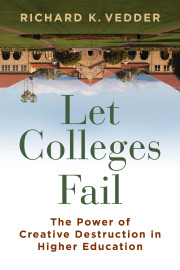The legendary President of the University of Chicago during much of the first half of the last century, Robert Hutchins, once said (according to Joseph Epstein in his great new memoir Never Say You Had a Lucky Life) that “football has the same relationship to education that bullfighting has to agriculture.” Hutchins ended football at Chicago, but the problems football could cause universities were then just in their infancy. What would Hutchins say if he were alive today?
Fast forward to the present era. Alabama football coach Nick Saban’s timing was exquisite. He announced last fall he was retiring from his position as the highest-paid person in college football, indeed I believe in all of higher education—meaning he was almost certainly America’s highest-paid public employee. He was giving up his $11 million-plus annual compensation as coach of the Alabama Crimson Tide. He lamented that football was not the same today with NIL (name, image, and likeness) deals for players, transfer portals, and other recent changes. Then came the blockbuster announcement that the NCAA and the five major power athletic conferences had agreed to an arrangement allowing the direct payment of salaries to college athletes, belatedly and tacitly admitting what the world had long recognized, that college sports are a professional, not amateur, activity.
For generations, top-flight college football and basketball players have received far less compensation for their athletic services than they would have in a competitive labor market. A decade ago, a superstar quarterback might have received benefits worth $50,000 or so annually—payment of tuition fees and some modest amount for living expenses—while adding perhaps millions to the school in revenues arising from a successful team—bigger ticket sales, more television income, dollars from selling more parking places, tee shirts, hot dogs, and even overpriced beer to thirsty fans. A huge portion of revenues from big-time college sports went to pay multi-million dollar salaries to head coaches and their more accomplished minions. Offensive and defensive coordinators, for example, at Power Five Conference schools typically make more than the university’s president or lesser public officials like the state’s governor or the president of the United States.
Until a few years ago, we were in a world where the total compensation to a very talented 21-year-old quarterback competing at a highly ranked school may have been $75,000 a year, while that of a 23 or 24-year-old recent graduate playing in the professional National Football League was $5-10 million annually. Yet the college kid’s coach usually made as much or even more as the coaches of NFL quarterback wunderkinds. Income was artificially but massively transferred between talented young men and their coaches—a peculiar but powerful form of financial child molestation. I once estimated that the financial exploitation rate of the average superstar college quarterback was far greater than that of prime slave field hands on the eve of the Civil War. The system started collapsing when NIL payments to athletics modestly lessened the exploitation; the current decree that salary payments cannot exceed $20 million per school won’t last long.
The ancien régime is dying, albeit without the guillotine drama (e.g., the beheading of Marie Antoinette) of the French Revolution. Let’s look at the finances. Even before the latest capitulation of the collegiate cartel, college football’s future was somewhat shaky. Most top schools already lose money on sports, at a time when college budgets have become more stretched. Laying out millions to college athletes has to be financed somehow—raising tuition fees to finance high living by so-called “students” adept at throwing and catching balls would be, to put it mildly, unpopular. I predict pay for top coaches will start falling, maybe to levels only two or three times that of the university president. More money will go for high salaries for talented athletes and less for luxurious locker rooms. The NCAA (which derives most of its income from its “March Madness” basketball gold mine) becomes increasingly irrelevant. Schools outside the Big Five Power Conferences will be unable to compete well (for lack of resources) and will become increasingly akin to baseball’s minor leagues. Other disasters loom as well, such as the prospect of massive lawsuits arising over long-term medical disabilities facing former football notables, or the growing fascination with soccer leading to a decline in football’s market share of the sports entertainment market.
Colleges may get innovative and essentially try to sell the use of their name to professional teams and unload their massive investments in stadiums and practice facilities. Is that viable? I don’t know. Much of the loyalty to university teams relates to affection for the school, including the non-sports dimensions, such as outstanding success in turning boys and girls into educated men and women.













